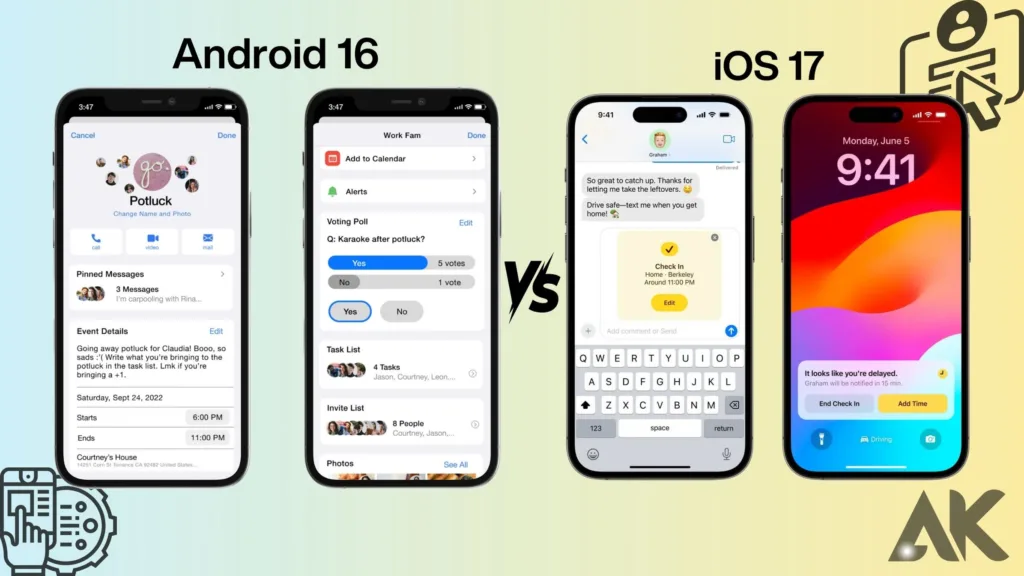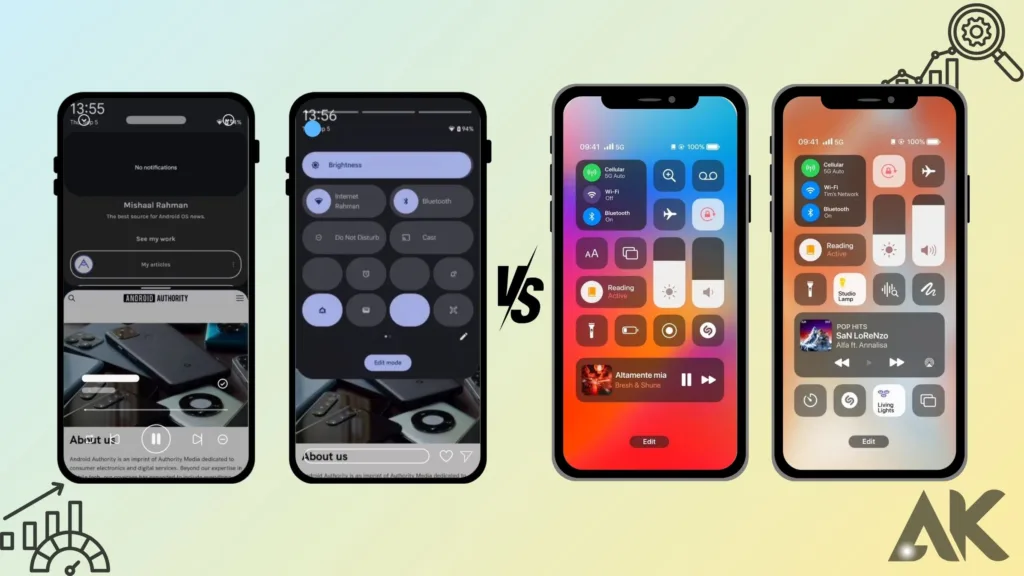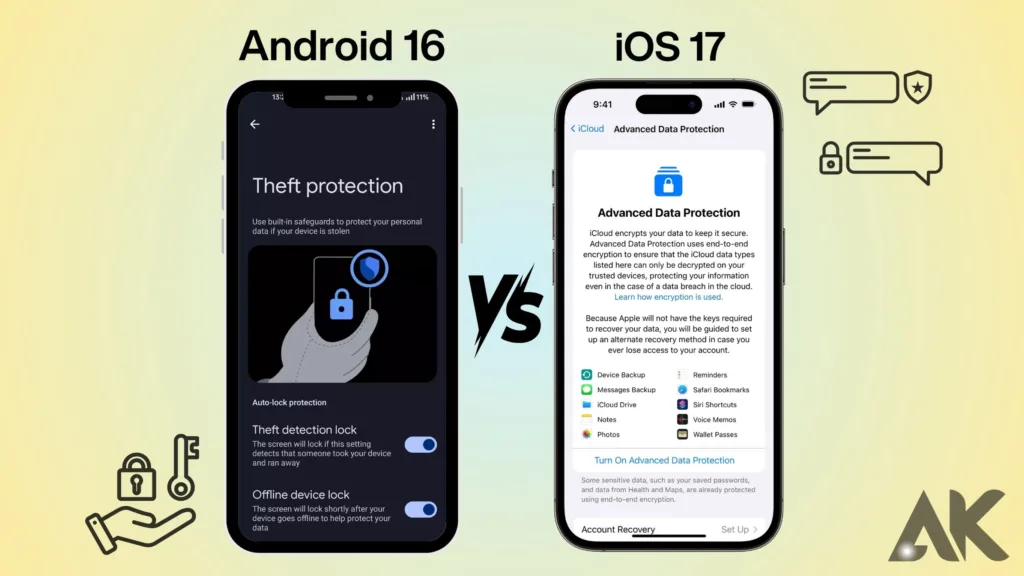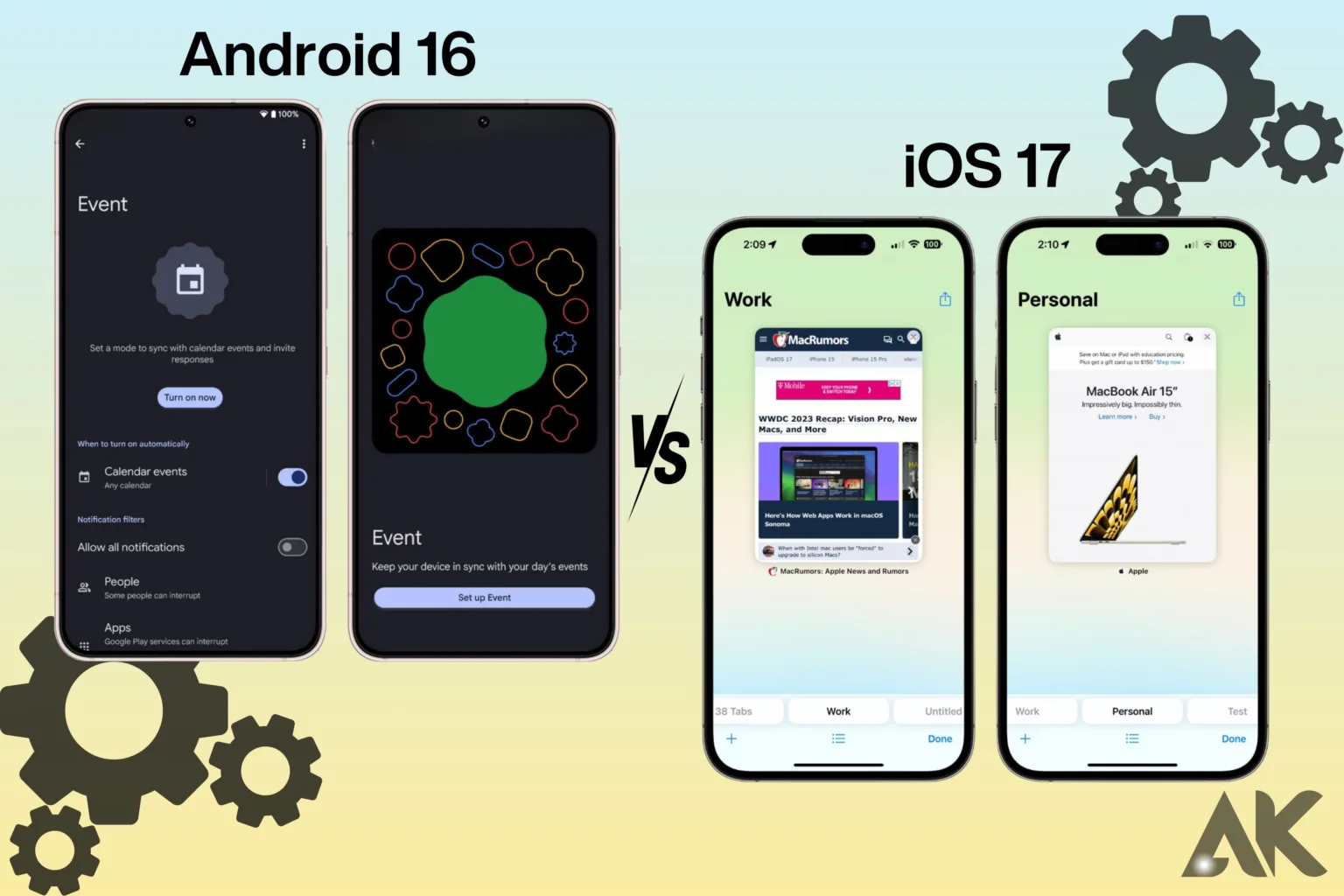The Android 16 vs iOS 17 argument is hotter than ever when it comes to the ongoing war between mobile operating systems. You can’t choose between them anymore because both have added cool new features. Android 16 is all about giving you more ways to customize your phone, while iOS 17 is all about making the experience smooth and easy to use, and it also has better private settings.
Android 16 vs iOS 17 is all about your own wants and preferences, not whether you prefer the flexibility of Android or the sleekness of iOS. We’ll show you what makes each operating system unique so you can choose the one that works best for you and your tech habits. Who will prevail in the Android 16 vs iOS 17 match? Let’s find out!
User Interface: A Visual Delight

| Feature | Android 16 | iOS 17 |
|---|---|---|
| Design Philosophy | Highly customizable with a focus on personalization. Users can change themes, icons, and layouts to suit their preferences. | Consistent design across all devices with a clean, intuitive interface. Customization is limited to widgets and rearranging apps. |
| Navigation | Gesture-based navigation with more options for multitasking and split-screen features. | Simplified gesture navigation, providing ease of use with a focus on a seamless experience. |
| Widgets | Advanced widgets with interactive capabilities, allowing users to access information directly from the home screen. | Enhanced widgets that blend seamlessly into the home screen, providing quick access to important information. |
In comparison of Android 16 vs iOS 17, Android 16 shines with its customization options, allowing users to truly make their devices their own. In contrast, iOS 17 maintains a more uniform design that many users appreciate for its simplicity and intuitiveness.
Performance: Speed and Efficiency

| Feature | Android 16 | iOS 17 |
|---|---|---|
| Speed | Optimized for various hardware, leading to smooth performance across a wide range of devices. | Fine-tuned for Apple hardware, providing a fast and responsive experience with minimal lag. |
| Resource Management | Improved memory management to handle multitasking efficiently, especially with the latest chipsets. | Efficient resource usage, ensuring background processes do not slow down the device. |
| Gaming Performance | Advanced graphics support and enhanced gaming features, including better frame rates and graphics rendering. | Dedicated gaming mode with optimizations for graphics-intensive applications and games. |
In Android 16 vs iOS 17, While Android 16 offers flexibility and compatibility with numerous devices, iOS 17 excels in performance by tightly integrating hardware and software for an optimized experience.
Security Features: Protecting Your Data

| Feature | Android 16 | iOS 17 |
|---|---|---|
| Biometric Security | Multiple options, including fingerprint, facial recognition, and advanced security features like Titan M2. | Enhanced Face ID and Touch ID with added security measures to protect sensitive data. |
| App Permissions | Granular control over app permissions, allowing users to manage data access effectively. | Simplified app permission management with clear indicators of data access. |
| Security Updates | Regular security patches and updates, but the frequency can vary by manufacturer. | Consistent and timely updates directly from Apple, ensuring all devices are protected against threats. |
Both Android 16 vs iOS 17 prioritize security, but iOS’s controlled environment often leads to quicker updates and more consistent security protocols.
App Ecosystem: Quality vs. Quantity
| Feature | Android 16 | iOS 17 |
|---|---|---|
| App Store | Google Play Store with a vast selection of apps, but varying quality due to less stringent review processes. | App Store known for high-quality apps and a more rigorous review process, ensuring reliability and security. |
| Third-Party Apps | More freedom to install apps from external sources, enhancing customization options. | Limited to the App Store, promoting security but restricting options for users. |
| Developer Support | Greater flexibility for developers, allowing for innovative applications but with potential quality control issues. | Strong support and resources for developers, resulting in polished and high-performance applications. |
In Android 16 vs iOS 17, Android 16 offers more apps overall, but iOS 17 tends to have higher-quality applications, which can influence user preference based on needs.
Customization: Personal Touches Matter
| Feature | Android 16 | iOS 17 |
|---|---|---|
| Home Screen | Highly customizable home screens with various launchers, icons, and themes available. | Limited customization, focusing on a uniform experience with some widget options. |
| Settings Personalization | Deep customization options for settings, allowing users to adjust nearly every aspect of the device. | More standardized settings layout, simplifying the user experience at the expense of personalization. |
| Ringtones & Notifications | Extensive options for ringtones, notifications, and quick settings access. | Fewer options for ringtones and notifications, focusing on a consistent sound profile. |
Android 16’s flexibility allows users to personalize their devices extensively, while iOS 17 provides a more uniform experience that may appeal to those who prefer simplicity.
Camera Capabilities: Capturing Life’s Moments
| Feature | Android 16 | iOS 17 |
|---|---|---|
| Camera Quality | Varies by device but often includes multiple lenses and advanced features like ProRAW and night modes. | Consistent camera performance with features like Cinematic mode and advanced computational photography. |
| Software Enhancements | Enhanced editing tools and AI features for better photo processing. | Powerful photo editing tools integrated into the Photos app, making it easy to enhance images. |
| Video Recording | Support for high-resolution recording and advanced settings for video enthusiasts. | Seamless video recording with high-quality results and user-friendly features. |
While both Android 16 vs iOS 17 offer impressive camera capabilities, iOS tends to have a slight edge in overall user experience and consistency.
Battery Life and Management: Keeping You Connected
| Feature | Android 16 | iOS 17 |
|---|---|---|
| Battery Optimization | Advanced features for battery saving, including adaptive battery and app usage management. | Intelligent battery management that learns user habits to optimize performance and battery life. |
| Charging Options | Supports fast charging and often includes innovative charging technologies like reverse wireless charging. | Efficient charging capabilities, with optimized charging features to extend battery lifespan. |
| Power Consumption | Varies by manufacturer, but many devices offer solid battery performance with adaptive features. | Consistently efficient power consumption thanks to software-hardware integration. |
Android 16 provides flexibility in battery management, while iOS 17’s seamless integration leads to consistent performance and longevity.
Updates and Support: Staying Current
| Feature | Android 16 | iOS 17 |
|---|---|---|
| Update Frequency | Varies significantly by manufacturer; some devices receive updates faster than others. | Regular, timely updates for all compatible devices, ensuring users have the latest features. |
| Longevity of Support | Generally shorter support period depending on the manufacturer and model. | Long support life for devices, often receiving updates for several years. |
| User Community | Large user base with diverse support channels, but fragmentation can complicate issues. | Strong user community with robust support from Apple, including in-store assistance. |
iOS 17 excels in providing timely updates and extended support, giving users confidence in their device’s longevity.
Conclusion: Making Your Choice
In conclusion, both Android 16 vs iOS 17 have their unique strengths and weaknesses. Android 16 offers greater customization and variety across devices, while iOS 17 delivers a polished, cohesive experience with a strong emphasis on security and timely updates. Choosing between them ultimately depends on your personal preferences, needs, and which ecosystem aligns better with your lifestyle. Whether you prioritize customization, app quality, or a seamless user experience, both operating systems are designed to cater to a diverse range of users.
FAQS
Q1. What are the main differences between Android 16 vs iOS 17?
A. Android 16 offers more customization, while iOS 17 focuses on a seamless, uniform experience with tighter integration between hardware and software.
Q2. Which operating system is better for security: Android 16 vs iOS 17?
A. iOS 17 generally provides faster and more consistent security updates, but Android 16 offers granular control over app permissions.
Q3. How does performance compare in Android 16 vs iOS 17?
A. Android 16 is optimized for various devices, while iOS 17 offers smoother performance due to its hardware-specific tuning.
Q4. How do app ecosystems compare in Android 16 vs iOS 17?
A. Android 16 offers a wider selection of apps, but iOS 17 typically provides higher-quality applications due to stricter app review processes.

